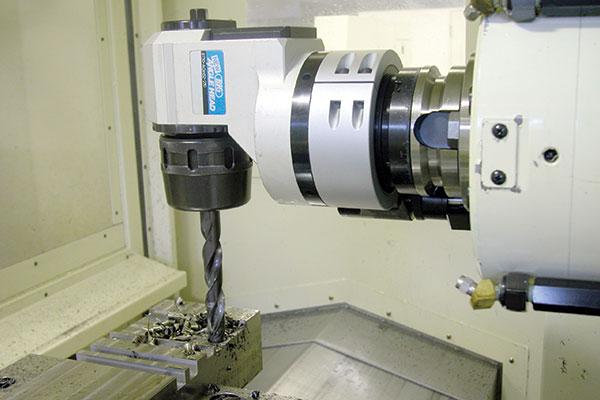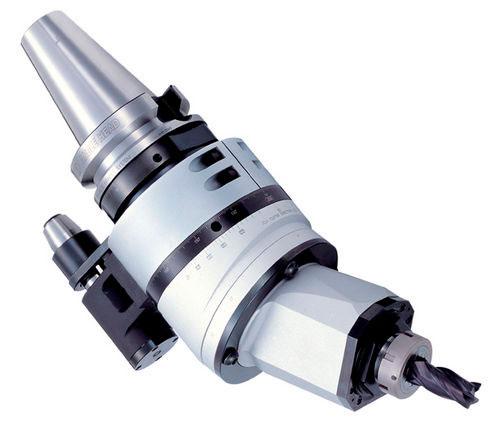- FMA
- The Fabricator
- FABTECH
- Canadian Metalworking
Playing the Angles
Using angle heads to reach inaccessible areas of the part, reduce setups
- By Joe Thompson
- January 13, 2015
- Article
- Metalworking

Angle heads can eliminate the need to move large parts, reducing setup time and improving part quality. Photo courtesy of Big Kaiser.
Editor's Note: This article is based on Big Kaiser Engineering Manager Alan Miller's presentation at the 2014 International Manufacturing Technologies Show in Chicago.
Angle heads allow horizontal, vertical, and angular machining operations to be performed without repositioning the workpiece. This increases accuracy and productivity and can create new opportunities for a shop.
Angle heads come in different shapes and sizes, and each has its own set of capabilities and limitations.
Some angle heads are suitable for drilling, tapping, reaming, slotting, milling, and finish milling. They also can be ordered with extended reach, and a relatively new type of angle head is adjustable.
“One of the more recent advances is the creation of an adjustable head,” explained Big Kaiser Engineering Manager Alan Miller. “It can adjust from straight out of the spindle [0 degrees] to 30 degrees offset from centerline. It uses a CV [constant-velocity] joint rather than gearing, which reduces backlash and creates better torque transmission.”
So when should a machinist consider using an angle head? There are five main situations. They are:
Machining in confined spaces. Angle heads add an additional axis to existing equipment that enables the machining of features that are otherwise impossible to access with the machine tool’s milling spindle.
“These days part complexity is the main driver in the use of angle heads,” said Miller. “More complex parts with difficult-to-reach features are pushing more machinists to angle heads to solve certain problems, including being able to reach inaccessible places on the part.”
Delay/offset new machine purchase. According to Miller, a common misconception about angle heads is that they are no longer necessary with the advent of new 5- to 9-axis machine tools. The reality, however, is that adding an angle head to existing equipment means a shop can delay spending money on a new machine.
“Given the right circumstances, adding an angle head can increase the functionality of an existing piece of equipment, freeing up money to be spent elsewhere,” he said.
Fewer setups.Angle heads give machinists the ability to finish a part completely without moving it to another machine.
“Adding an angle head to an existing machine can eliminate the need for secondary machining,” said Miller. “If there are one or two small features that need to be added to a part, it certainly makes sense to create these on a single machine using an angle head. However, if you have to machine several features requiring five or six different angle heads, then it probably makes more sense to produce that part using a second machine.”
With the elimination of secondary operations, part quality is improved, WIP is reduced or eliminated, and cost per part is lowered.
Create more complex parts. Complex part features can be performed by using an angle head. For example, using this type of equipment enables machinists to mill internal slots that are common in today’s energy and construction components.
“In the energy industry, for example, we see a lot of key slots being machined using angle heads that would previously have been broached in. Although, the decision whether or not a part stays on a single machine until completion still is based on its complexity, cycle time, and shop setup,” said Miller.
Reduce cycle times. An example of this is using an angle head to create slots with a slitting saw and angle head rather than a small end mill, which reduces machining time.
Like any machining operation, cutting with an angle head requires programming of the machine.
Most CAM packages have built-in functionality for angle heads as part of their offerings. Once the angle head is set up as part of the machine, programming typically is pretty simple and straightforward.
“There are some times when you do wind up hand-programming the angle head, but today there are some pretty advanced features in most CAM systems that allow you to either shift the origin point or work in different planes that take the guesswork out of the equation,” said Miller.
Quite often these functions fall under the Aggregate Heads menu of the CAM system. Canned cycles also are typically available, but according to Miller, these cycles usually are usable only if the angle head is set parallel to an axis.
Advanced techniques such as those using G68 can be used, but they make programming more difficult.
CUTTING METAL
Steel: Because of the head’s lack of rigidity when compared to the machine’s spindle, Miller recommends using high-speed steel (HSS) tools and conventional cutting techniques similar to those used in manual milling.
“These are spindle attachments, not machine tool spindles,” he said. “You have to use more conventional paths because climb milling is too rough on the angle head. Also, HSS tools are best because carbide is too stiff.”
Aluminum/nonferrous metals: Carbide cutting tools can be used in aluminum and nonferrous parts applications, and the climb milling technique can be used in the finishing operation.
MANAGING EXPECTATIONS
The successful implementation of any new technology occurs by fully understanding the abilities and limitations of the equipment. With angle heads this means understanding three factors. They are:
Rigidity. An angle head is not a milling spindle and will not have the same rigidity. This means deflection will occur, especially in hard material. Angle heads are not recommended for materials harder than 40 HRC.
Power. Angle heads have limited horsepower. Small units typically have around 1 HP, midsized units have up to 3 HP, and the largest units have up to 5 HP.
Cycle time. Angle heads are designed to run for a maximum of only 30 minutes continuously. Coolant lines need to be plumbed down to the stop block to keep the geartrain temperature low. The maximum increase in temperature allowed is 85 degrees F.
Cycle time can, however, be extended to one hour if the system’s speed is running at less than 50 percent. Also, a light finishing process can be run at 100 percent speed for an hour.
subscribe now


Keep up to date with the latest news, events, and technology for all things metal from our pair of monthly magazines written specifically for Canadian manufacturers!
Start Your Free Subscription- Trending Articles
- Industry Events
MME Winnipeg
- April 30, 2024
- Winnipeg, ON Canada
CTMA Economic Uncertainty: Helping You Navigate Windsor Seminar
- April 30, 2024
- Windsor, ON Canada
CTMA Economic Uncertainty: Helping You Navigate Kitchener Seminar
- May 2, 2024
- Kitchener, ON Canada
Automate 2024
- May 6 - 9, 2024
- Chicago, IL
ANCA Open House
- May 7 - 8, 2024
- Wixom, MI















